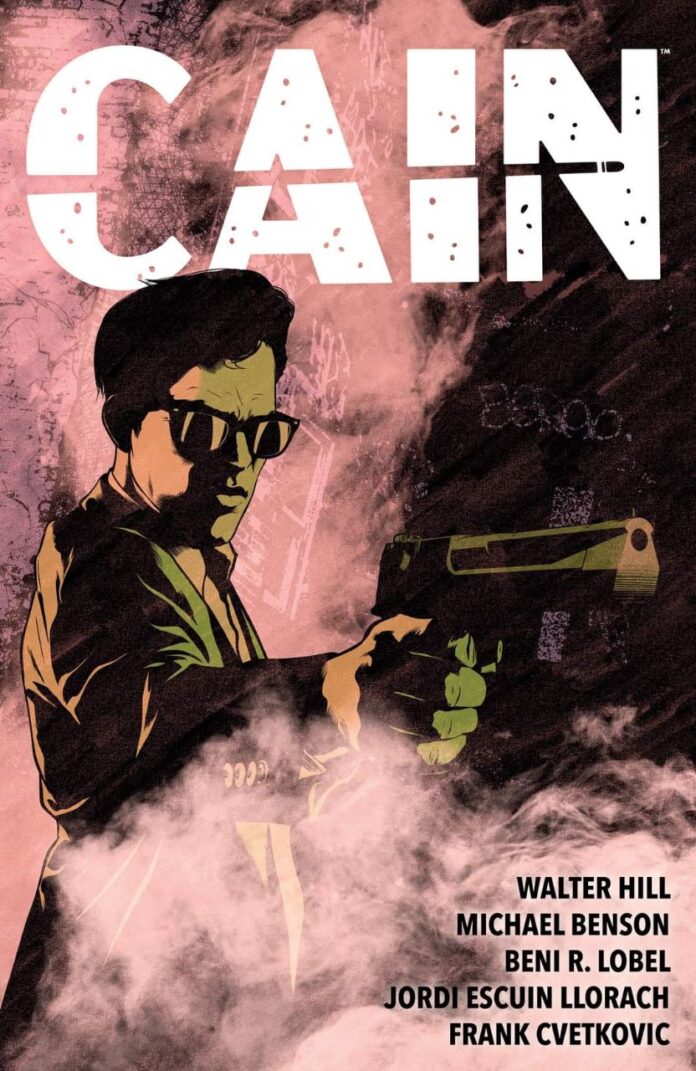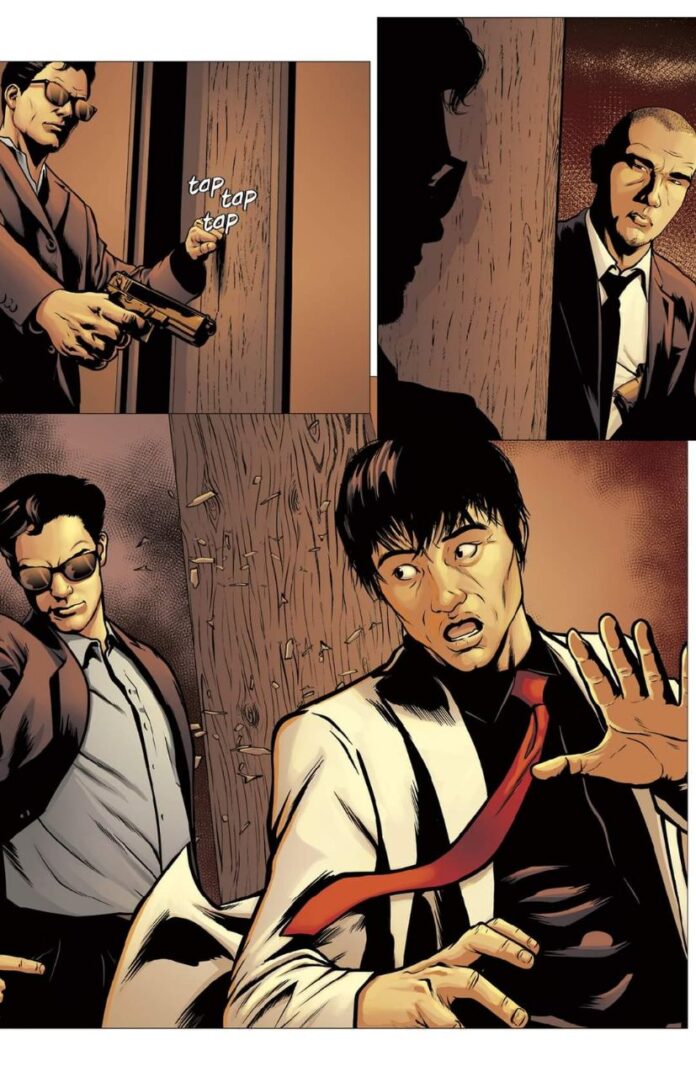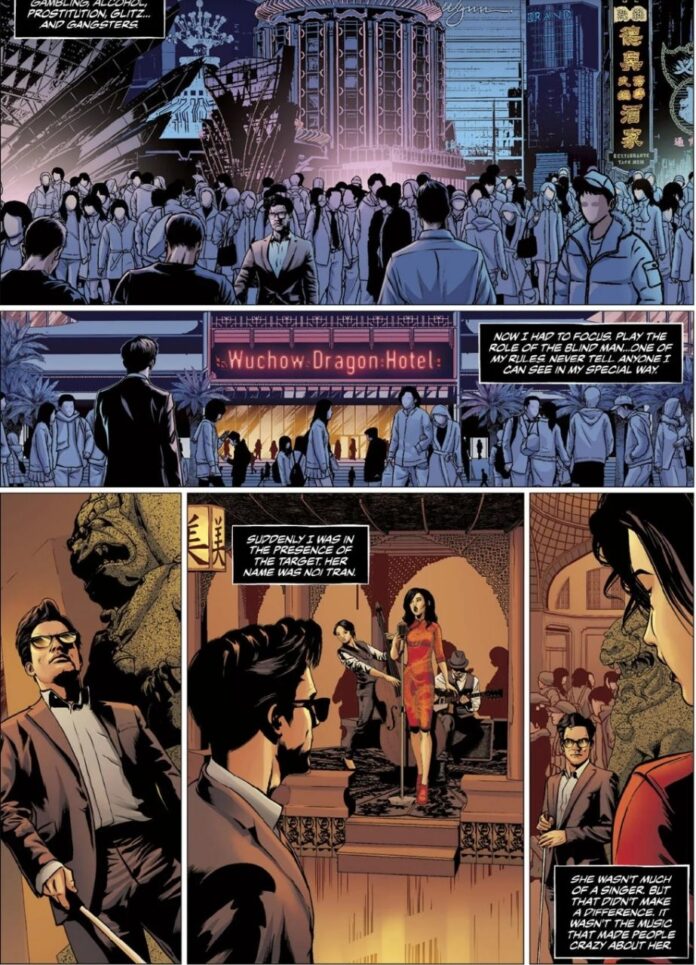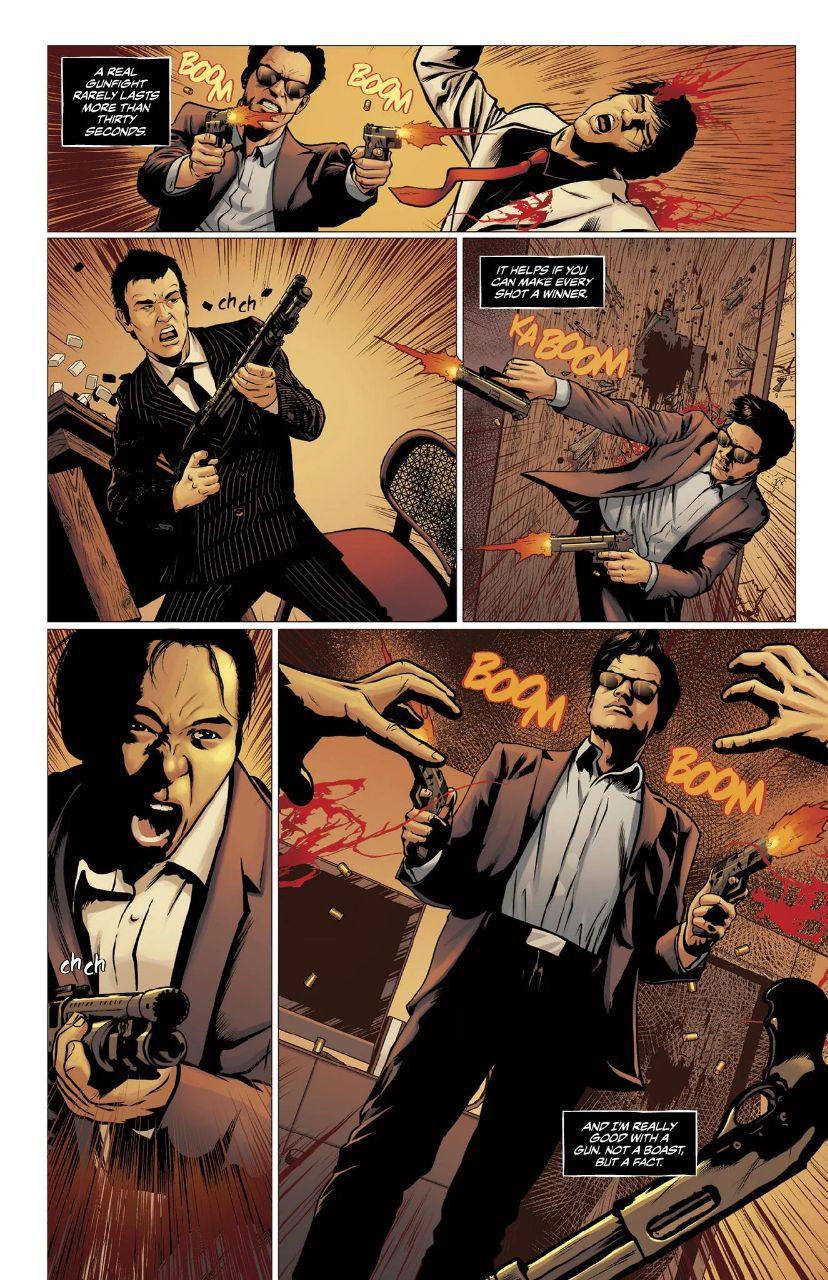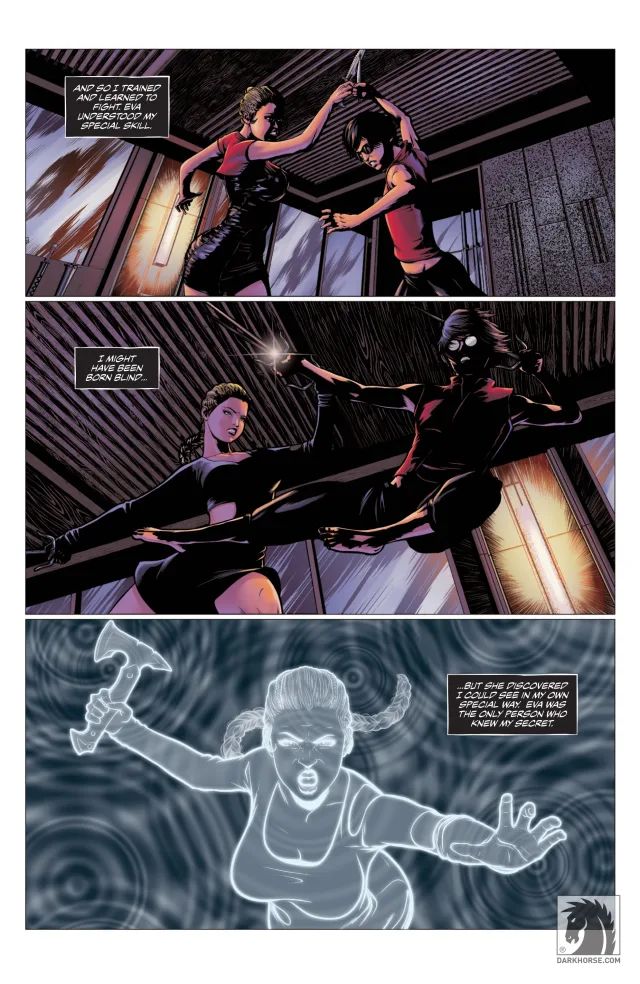Fans of director, producer and screenwriter Walter Hill have good reasons to celebrate. On December 6, 2023, Dark Horse Books published the graphic novel named Cain in the US. The filmmaker’s fourth illustrated adventure, is the first one published in his native land, which is based on a script and a story he created, as can be immediately recognized.
Cain is, like Roy Nash or Frank Kitchen, other comic characters created by the Long Beach filmmaker, a hitman, with the peculiarity that he is blind, and specializes in killing despicable human beings. He enjoys it. Gangsters, corrupt politicians and traffickers of girls taken from Africa with the sole purpose of pleasing the depraved people who pay astronomical amounts of money (in what would be the last phase in the colonization process of the black continent, like someone says). This entire gallery of human misery falls like flies before their relentless automatic pistols that spit death in abundance.
Between briefcases plenty of money and accurate shots in the dark, the murderer occasionally decides to reestablish a bit of order and justice in the universe, although such decisions do not constitute economic profits at all. To fall on his target, and any sicario who gets in the way, Cain always takes advantage of the ‘element of surprise’, which as Cain says ‘…usually carries the day’. Whenever he can, he leads his enemies into darkness. ‘…Once you’re in the dark, I’m the boss’, stands his reflective voice off-screen, a narrative resource that Hill uses as anyone does.
The hitman is a sex addict, a circumstance he explains by stating that he has always been tremendously attractive to women. He travels to different places on the planet. In Macau, which he considers Hong Kong’s Las Vegas replica, we see him on a killer’s shoes for the first time, in a sequence that is a tribute to the choreographed action scenes of Hong Kong film director John Woo (you even can imagine the slow motion sequence reading the comic book); Paris and its Latin quarter, in the fifth arrondissement, serves the purpose of meeting Garance, a high-level prostitute, and the former Spanish police officer Esteban, who knows the Parisian underworld pretty well, and where the main character decides to take down a pervert influent person. A real big shot whose death is current new on television; In Madrid, after a boring museum session, he makes the decision to go to the controversial Montera Street, the famous perpendicular of Gran Vía towards Puerta del Sol, and carry out one of his acts of poetic justice, releasing a prostitute, a young woman from Málaga, from the clutches of his violent pimp.
Among his hedonistic activities, like the legendary character Wild Bill Hickok, in Walter Hill‘s 1994 film, the (anti)hero goes to his favorite opium den, in China, to smoke from a pipe, experiencing sensory journeys, in what he calls ‘…trying to send myself into the fourth dimension’.
Cain’s blindness is not a problem, nor a disability to function, since he has an important sensory ability. The sound that comes from the movement of the bodies draws in his mind the silhouette of the people who usually move around him. Cain is also undisputed in hand-to-hand combat, thanks to the training of CIA agent Eva, who took him from an orphanage and trained him in the art of war. All these factors appear in the construction of the character intermingled with a piece of integrity in the path undertook by the hero, an honesty quality that is very appreciated by the Californian film director and screenwriter in his own stories.
PASSION FOR COMICS
Walter Hill‘s passion for graphic novels is well known and dates back to his childhood. Since he was an asthmatic child (had to spend a lot of time alone, without going to school), he devoured the comics that fell into his hands (from Flash Gordon to Roy Rogers), as well as those films that forged his own imagination, such as Stagecoach (USA, 1939), directed by John Ford, or High Sierra (USA, 1941), by Raoul Walsh, probably his favorite American classic film director. His script for The Gateway (USA, 1972), directed by Sam Peckinpah, is dedicated to the memory of Mr. Walsh. Of course, also the great novels of universal literature, like Borges, Homer, and Hemingway (especially his laconic short stories), made an appearance in Hill’s imaginative mind in childhood and early youth. All these artistic expressions, opened the filmmaker’s mind to different levels and ways of telling his own stories, which always reflect the purity of his childhood tastes, which remain amazingly intact beyond 80 years of age.
IMAGES WITH VIGNETTE AROMA
That specific passion of Walter Hill for the language of comics remains perfectly exposed in some samples of his cinema, without too much efforts. The aesthetics of The Warriors (USA, 1979), especially in the 2009 cut, where an introduction appears in vignette images (which serve as support for the director’s own voice over, explaining the parallelism of the story to be told with Xenophon’s Anabasis). Throughout the film, seven other static drawn images make up as illustrated panels, which transition from one sequence to another. These fresh ideas, incorporated, as we say, in 2009 to the 1979 film, don’t leave much room for doubt, regarding the director’s taste for the graphic novel.
The transitional effects that can be seen in some moments of Streets of Fire (USA, 1984), increasing the sense of acceleration to the already frenetic pace, also provide some evidence of that passion. Last Man Standing (USA, 1997), his particular adaptation to Akira Kurosawa’s universe, establishes a straight dialogue with the concise “language” of the graphic novel’s narrative, as demonstrated by certain thematic similarities and historical location of this film with the comic The Triggerman (known in France and Spain as Balles Perdues and Balas Perdidas, respectively, that means lost bullets, a title full of poetics and fatalism).
In his film The Assignment (USA, 2016), Hill reiterates the idea he used in the 2009 version of The Warriors of including the aforementioned comic panels, which link the end of some image with the beginning of the following one. He also made an extremely interesting and enriching decision. The filmmaker decided that this 2016 film would dialogue with a version in graphic novel format. His film Bullet to the Head (USA, 2013) is, on the other hand, the film adaptation of the comic by Wilson and Alexis Nolent (known as Matz), of the same title. Hill met Nolent while both were promoting the 2013 film in New Orleans. As a result of that meeting, a friendship and a fruitful professional collaboration arose, which has led to the creation of three graphic novels, some already mentioned, for the French publishing house Rue de Sèvres.
THE THREE STORIES TRANSFORMED INTO VIGNETTES FOR THE FRENCH PUBLISHER RUE DE SÈVRES
The Triggerman introduces Roy Nash to the audience, a hitman in Prohibition era, who is taken from Joliet prison, a very harsh condition and antique penitentiary located in Illinois, where he is serving a life sentence, to find a mafia money that was stolen by three small-time crooks. The ultimate argument to recruit Nash has to do with an important fact: the great love of his life, he has a photograph in his pocket watch, is dating with one of the three scoundrels.
This comic was published in the US by Titan Books, in an edition that contains additional images with a marked pulp tone, more typical of the time in which it takes place, early 30’s, pictures not published in other markets. In Spain, Norma Editorial produced a commendable hardcover edition, which includes a brief interview with the creator, like French edition.
Bodies and Souls constitutes, as has been said, a comic version with some interesting variations regarding the film The Assignment (shares its title in US publishing) which tells the story of the hitman Frank Kitchen, who undergoes a sex change against his will, as a revenge carried out for a little unbalanced doctor female who has lost her brother, terminated by the tomboy (original title for the screen story, back in the 70’s). The comic explores aspects such as the sex change of the protagonist, or his relationship with the young nurse, in a different way than the film, although in essence it’s a story told on the old fashion way: murderers, gangsters, gunshots, tobacco smoke, revenge, economic interests and dilemmas that test the integrity of the protagonist. This sensational work has also been published in Spain by Norma Editorial.
Le Spécimen, for its part, is a science fiction plot set in the snowy landscape of Siberia, whose protagonist is Dr. Irina Danko. Bridging the gap, it shares with the film The Thing (USA, 1982), by John Carpenter, as well as with the classic original film, The Thing (USA, 1951), by Christian Nyby and Howard Hawks, the desolate snowy landscape, surrounding an isolated built environment, and a science fiction plot with a creature, although this time it is not such monstrous shape. As a differentiating element, the plot of Le Spécimen is completed with some leaps on time and space, namely to other centuries, like Central Europe, in 1880, Paris, 1840, Berlin, 1928, or Rome, 1st century BC. This fascinating piece of sci-fi work is conceived by Hill in a genre rarely approached, with the exception of his contribution (with his longtime companion David Giler) to the Alien saga, or his willingly uncredited participation in Supernova (USA, 2000), by Thomas Lee. Le Spécimen is not published except in the French market, up to now.
THE ELEMENT OF SURPRISE USUALLY CARRIES THE DAY
Walter Hill‘s fourth work for the comic language, constitutes, as we said, his editorial debut in his country after his three French adventures. Opening wide is Dark Horse Comics, an independent, autonomous production company, founded in 1986 by Mike Richardson, but with great weight in illustrated publishing. The firm has an enormously personal history in the world of graphic novel. Super heroes like Hellboy, the creation of Mike Mignola, graphic novels like Sin City, by Frank Miller, comics that explore film sagas like Alien, Predator, Terminator, or the Netflix series Stranger Things, stablish an important part of its legacy.
In 1992, Dark Horse Entertainment was created to produce films mainly based on its comics, and they participated in the development of the two Hellboy films directed by Guillermo del Toro, as well as the two crossover films of the Alien and Predator sagas. In 2004, DH Press appeared with a range of novelizations of its most popular comics.
Well, the remarkable graphic novel that Dark Horse put into circulation in the US at the end of 2023, creates an alliance between Hill and screenwriter Mike Benson, author of other remarkable comic works about superheroes such as Punisher, Luke Cage, Wolverine, or Moon Knight and for television in shows like Big Wolf on Campus or Entourage, among others.
Cain also puts the Long Beach filmmaker in contact with two Spanish artists based in the American market. Born in Valladolid, the illustrator Beni R Lobel is the author of graphic prequels to films such as After Earth or Avatar. His style between chiaroscuro and realism can be seen on the cover of the comic, which is an important part of his creation. The name of the protagonist, which contains numerous bullet holes, moves between the pink neon light of pink Chinese characters and complete darkness goes towards the right of the cover. The silhouette of the protagonist, in greenish color (as the result of the reflection of a light from outside), carrying one of his automatic weapons, runs from left to right across the cover, parallel to his name.
The Spanish designer and colorist, Jordi Escuin Llorach, trained at the Llotja Higher School of Design and Art, also participates in the creation of this comic, by deciding the color range in the images.
Finally, in the creation bunch of Cain we have the graphic novel letterer and also screenwriter, Frank Cvetkovic, the fifth essential name in the authorship of graphic novel Cain. Cvetkovic is in charge of the design, size and location of the letters with the images. A perfect example of the admirable coordination of the aforementioned artists and their way of acting as a spearhead, can be checked and appreciated in the unforgettable segment that takes place in Paris, France. It begins with the image of Garance sitting on a stool, wearing a short dress and legs crossed, back to the bar, looking at Cain (sitting at a table, drinking and wearing his sunglasses) in a bar-restaurant located in the Parisian Latin neighborhood. The set piece finish at the Gare Du Nord station, where the blind hitman takes the bullet train to Spain. The illustrated French sub plot is visually constructed with an imaginative melting pot of color tones and language variations, ranging from an apparently banal conversation, to the illustration of the central character’s thoughts, to a fashion show, unbridled physical action, or the sexual sodomy that the high-class prostitute is willing to provide to her demanding clients. A marked dark light that seems to have come out of a Caravaggio canvas reigns in the texture of the vignettes in this unbeatable segment.
THE HERO’S PATH TO THE PANTHEON
The journey proposed by the story created by Walter Hill for Dark Horse Books constitutes a story with noir aesthetics, where people smoke and drink in abundance, have sex without major dilemmas, and where we meet again with tremendously tough characters in front of to the greatest vulnerabilities wielded by some figures that fall like evergreen leaves. Aspects such as violence, loyalty and betrayal, and of course, dealing with death, come running in a story that is constructed in some aspects as a nostalgic ballad, seasoned with smell and flavour of great genres, such as western or the thriller. It is unavoidable, while reading, thinking about characters like Daredevil, the blind lawyer protagonist of his own Marvel comic series, and in particular in his version scripted by Frank Miller (a character also taken to film and television), or the murderer blind man who works for the “High Table”, in John Wick 4 (USA, 2023), directed by Chad Stahelski, who is called Caine, played by Donnie Yen, one of the most popular Asian actors and martial artists of all time. However, the personality of the Californian Walter Hill delimits and leads the high personality of Cain character to his glorious pantheon of upright heroes in one piece, where Cain shall share the stage with such characters as The Driver, the mercenary Tom Cody, the gang member Swann, the robber Johnny Sedley or the murderer John Smith, among others.
Cain fits, in a very consistent way, in the Hill’s universe of tough guys, faced with important moral crossroads. You only have to pay attention at the decisions that the blind character makes regarding the young Asian woman Noi Tran (‘she is a lost soul who has given up all hope’), whom he first rescues by shooting from the triad (the Chinese mafia), but then he must return her to the mob, because, as the young woman has established, they will kill her family in Vietnam if she doesn’t return. Another rescue takes place in Los Angeles. In this case, Carmen, a young Latina female, girlfriend of the head of a street gang called Calle León, from the multicultural neighborhood of Boyle Heights, whose leader hires Cain to rescue her, as she is a prisoner in the hands of a Culiacan cartel, as a consequence of a territorial and percentage dispute.
Cain‘s texts are, as always in their author, sparse, sober, simple, never banal, laconic, straight and very powerful in terms of launching some ideas about the mail character and his reflections, his voiceover, as well as regarding the crucial decision-making, in a world where violence reigns. In the construction of the voice over, which as always conveys the hero’s disenchantment, in the Spartan use of words, loaded with irony and great forcefulness, or in the integration of the action with the personality of its protagonist, it calls the attention as Hill remains intact, as we say, from the distant times in which he devised his first scripts, back in the late 60s.
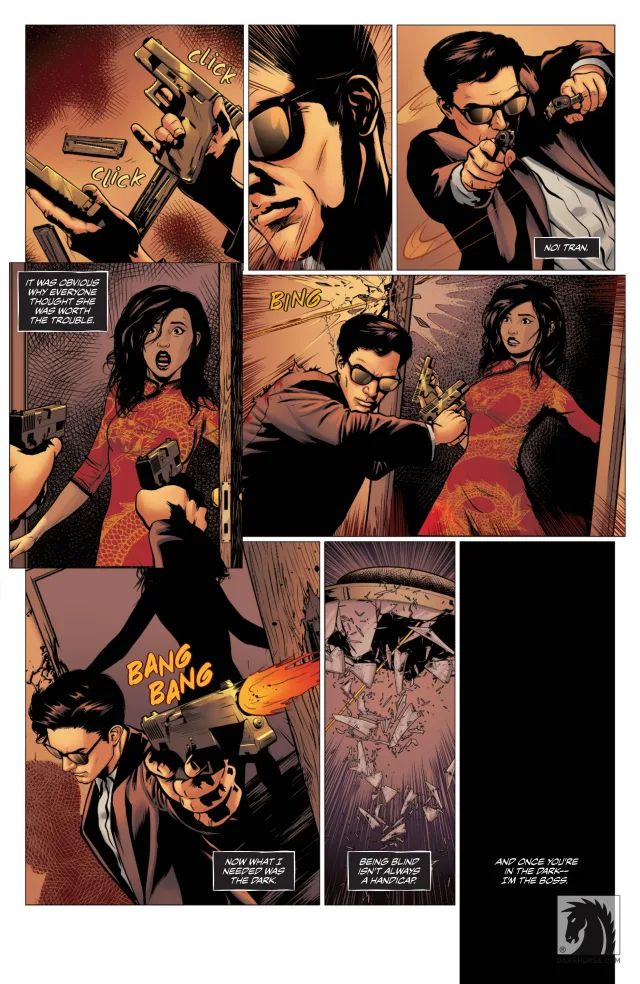
TO BE CONTINUE…
The universe of this blind assassin who has the ability to sense the world around him, transcends a single volume. The story clearly continues beyond the end of the pages. This occurs for the first time in the filmmaker’s career as a comic book writer. The three previous stories published in France are conclusive. The current editorial fashion about publishing stories for two or three volumes goes a long way. Either way, long stories, which expand the universe of their protagonist, constitute a novelty in the director’s way of conceiving stories, which always tend towards containment and brevity.
Along these grounds, reading Cain, the fresh new graphic novel written by Walter Hill, published by Dark Horse Books, constitutes a complete sensory delight, which awakens a whole component of evocation and nostalgia for genre stories, which turns reading it into a very exciting and astonishingly experience.
